1-3-1 Versoix
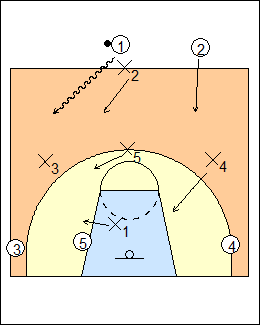 | 1 This 1-3-1 tries to keep the ball on one side, slow down perimeter ball movement (no direct passes), and keep the ball out of the high post. Point X2 gets the ball out of the middle, denies ball reversal, is the long middle rebounder, can trap the high post with X5. Wings X3 and X4 start high, push the ball out on a pass to a wing, and mirror each other, one wing distorts the passing lane to the ballside corner, the other is weakside basket protection. Middle defender X5 plays high between the ball and the basket, and defends dribble penetration. Baseline runner X1 covers corner to corner, covers the low post with the ball on the wing. If the point guard is not the baseline runner he will usually be the point defender. Sergio Scariolo (FIBA Assist 34) - they can afford to have a small player at the point of the zone but he must be very smart. The 1-3-1 is set only when the ball is out of bounds (i.e. not on a defensive rebound). Aldo Corno (FIBA Assist 20) - the main aspect of this defence is to cover the passing lanes, forcing slow lob or bounce passes, and inviting penetration to the middle. Bob Hurley - put the quickest guard on the left wing (the most important position), tallest of the other two guards at the top, smallest guard at the back, 5 in the middle, and 4 on the right wing. The 1-3-1 is good against a small team and good shooters. Sidelines (Feb/Mar 2009) - the 1-3-1 trap can really rattle the opposing point guard. Don't let them run their sets. The point defender is athletic and long, and the primary trapper and stealer. The best defender is on the baseline, hard-nosed, can take charges, rebound well, and run sideline to sideline and not get tired. Reggie Kohn (FIBA Assist 44) - general rules are keep hands straight, force passes over your head or around your body, try to kick any ball passed around you, line up on the outside shoulder of the ballhandler, one defender is always jabbing at the ball, and push the ball out towards halfcourt. The defence is great against a great scorer, they never get comfortable and in a rhythm. |
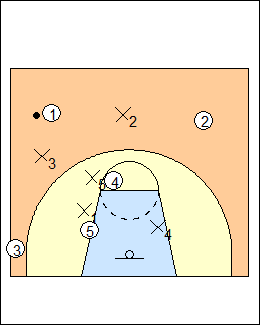 | 2 Play in the passing lanes with high hands to slow down perimeter passing. With the ball on the wing, X3 plays wide with his back to the baseline to deny a direct pass to the corner (X1 talks to him), X2 denies ball reversal (X5 talks to him). However, when the corner trap is "on", optionally X3 will open up a bit (with his back to the basket) to promote a pass to the corner. Another option is that the ballside wing pressures the ball but does not contest a pass to the corner if the defence is more concerned about protecting the paint. Dribble penetration to the middle is closed down by X3, X5, and X2, but especially by X5. Trapping is optional. coachesclipboard.ca - wings X3 and X4 pressure the ball when it is on their side. Jack Bennett - with the ball on the wing, X3 takes the ball with high hands to slow down a pass to the corner, X2 plays cat and mouse, forcing an over-the-top pass. Ed DeChellis - there is always ball pressure when the ballhandler has his dribble; if he picks it up, get back in the passing lane. Pressure comes from the point or the wing, if the wing pressures, the point backs off in between the ball and the next offensive player. Apply fake pressure, make teams feel like they are going to be trapped. Seth Greenberg - X5 attacks all dribble penetration, forming a cup with the point and ballside wing, X1 and the weakside wing cover the blocks. X3 distorts the passing lane to 3 (X1 talks to him). If 2 is a shooter, X3 puts hard pressure on the ball, X2 backs off the ball and cheats towards the shooter. Lute Olson - every drive is taken by X5, the ballside wing stays home. Billy Tubbs - invite penetration, it ends up being a double team, by X5 and X2, X3 stays in the passing lane to 3. Scariolo - X5 gives first help on dribble penetration, not the perimeter defenders. Kohn - X2 and X3 face the ball, jab and bounce back with hands straight up (X3 first touches 1). X2 is in line with 1's high shoulder, X3 in line with the outside shoulder. X5 should meet dribble penetration outside the 3-point line, and X2 and X3 collapse to triple-team the ball. |
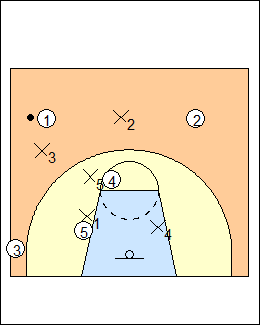 | 3 X1 plays the ballside low post in front, he has to get out to 3 on a pass to the corner. X5 covers the high post, but if there is no attacker there he can drop down a step or two to help on the low post (DeChellis). X1 can play in front but outside 5, with his right leg over 5's left leg and jamming a pass with his right hand. See Tubby Smith 3-2 and Pistons 1-2-2 match-up. If the attacking set has only one post player, optionally X5 guards him man to man (coachesclipboard.net), X1's concern is 3. Greenberg - with the ball on the wing, X5 keeps the ball out of the high post, denies from the side, goes behind on a guard-to-guard pass. X1 sits on the top leg of 5, he can't get screened on a pass to 3 in the corner. Jack Bennett - X1 will 3/4 or front 5. DeChellis - usually front the post unless you want the ball in there. Most teams use a 2-1-2, getting a good player away from the basket. Corno - X5 fronts the high post, and is ready to slide down and front the low post. Don't ever let the ball enter the high post, it's the most dangerous spot on the floor. Scariolo - X1 tries to front 5, but if he doesn't manage to do it they send X5 to double-team on a pass. If the ball goes to the high post they guard him one-on-one, if he puts the ball on the floor the point defender tries to get it from behind. Jack Bennett - on a pass to a high post, X2 double-teams with X5. Kohn - X5 fronts the high post (or optionally plays 3/4 stance), and communicates 2's location to X2, so he can stay in the passing lane. X1 sits on the ballside block and fronts any attacker, he can't cheat out to the corner. X4 covers the weakside block, but can cheat out to the wing if quickness allows him to still protect the basket. |
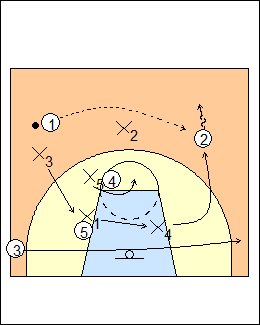 | 4 On ball reversal to 2, X4 comes out wide (no direct pass to the corner) and pushes the ball out (Ed DeChellis). Greenberg - on a guard-to-guard pass, X4 doesn't worry about what's behind him, he attacks the ball and pushes it out, forcing a back dribble, buying time for wing X3 to take away a weakside diagonal pass. X4 can then bluff and retreat, concern himself with a pass to the corner. Scariolo - X4 goes out unless 2 is very high, then X2 would take him and X4 get on the passing line to avoid a direct pass to the corner. Kohn - X2 turns towards halfcourt (keeping on the high shoulder), sprints towards 2 with his hands up, continues to jab and bounce back. X4 sprints to the sideline at the foul-line extended with this outside hand out, taking away a pass to 3, then moves up to 2 with his hands up, on the outside shoulder, touches 2, and starts to jab and bounce back. X3 sprints on a direct line to cover the block and basket. Bennett - the weakside wing drops to form a triangle. X1 covers the baseline in thirds. |
 | 5 A coaching option is to trap on the wings, the trap can be quick (go on the first dribble in the backcourt) or slow. Here X2 and X4 are the trappers, X5 and X1 are interceptors, X3 is the goaltender, protecting the basket. DeChellis - they don't trap on the wing. Sidelines - don't run at the ball, be patient, X2 channels the ball to a sideline, then aggressively trap, most of the time X2 will be able to deflect the ball or force a turnover. The only easy pass you want to allow is the reversal back to 1. If this happens, X2 and X3 try to trap on the other sideline. If the pass goes down the other sideline to the corner, trap again before they can shoot the 3-pointer. The whole purpose of this defence is to create turnovers. Corno - after a free-throw, trap right after the halfcourt line, X5 fronts 4, X1 covers the corner or low post, X3 slides down to steal the potential diagonal pass and protect the basket. Look for X1 or X3 to intercept a pass, leaving 1 open, the least dangerous player. If they decide to continue with high traps, on a pass to 1, X2 and X3 would double-team. If they don't want too many risks, double team only in the corners after the first trap. Scariolo - X2 forces the ball to the sideline, they jump to trap just as 2 crosses the midcourt line. X3 calculates the risk of stealing a pass to 1 but 4 can't go behind his back. Don't trap if the offence has two guards in line before crossing halfcourt, they probably want to draw the double-team then change the ballside, X2 defends by faking, his job is to avoid horizontal direct passes. When the ball goes out of a double-team, the defence will be in trouble. coachesclipboard.net - trap again on a pass to the corner, however a pass out from the corner usually can't be trapped, just try to contain the ball, then trap on ball reversal to the other wing. hooptactics.net - X1 denies the sideline passing lane, X5 prevents a pass into the high post area (keep the ball out of the middle), X3 anticipates a pass to 4 or 1 (cut off a cross-court pass). For a quarter-court trap against teams that spread the court and hold the ball, double team in all four backcourt corners, or, against good passers, designate one corner as "home" (usually the opponent's worst ballhandler), where defenders match up rather than trap, leaving no open player. |
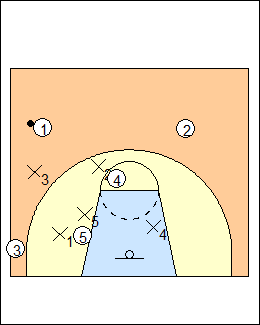 | 6 To counter an overload with attackers at the high post, low post and ballside corner, optionally slide defenders down so that X2 covers 4, X5 covers 5, and X1 is outside 5 anticipating a pass to the corner. The defence looks more like a 2-3 zone, and is not extending to contest ball reversal. See the Lute Olson 1-3-1. |
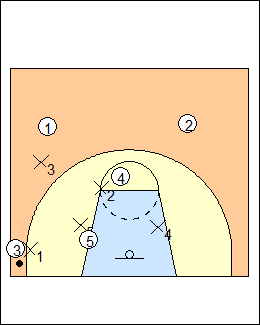 | 7 When the ball is in the corner, X1 takes away baseline (see Lute Olson, Seth Greenberg). The ballside wing double teams if the trap is on, covers the pass back out (the default), or covers the sidepost, e.g., if the other team has a strong low and high post. Here X3 denies a pass back out (soft trap), X2 has the elbow and distorts a skip pass with high hands, X5 is between the ball and the basket, X4 protects weakside. X5 will usually 3/4 from the topside, but can front, or play behind a non-shooter. Stave Klass - there is a strongside box. Greenberg - X3 soft traps, X1 takes away baseline, X5 defends 5 on the baseline side, X4 will sit on the top leg of an attacker not to get screened on a skip pass to 2, X2 keeps the ball out of the high post (elbow) and distorts the skip pass to 2 with high hands. Scariolo - X5 does not defend outside the paint, playing behind the low post. If 5 gets a pass X5 faces him one-on-one. Against zone defence post attackers have more of a passing than scoring mentality. Kohn - X2 covers the ballside elbow, hands up to help prevent a good skip pass. X5 fronts or plays 3/4 high side. X3 turns outside, keeps hands up, sprints to a soft trap, starts to jab and bounce back, and will stay about 5-6 feet away from 3. X1 sprints out to 3 on the baseline side, not allowing him to go baseline, and will run out only to 15 feet if 3 is a non-shooter. On a pass to 1, X2 would sprint towards halfcourt with his right hand out to discourage ball reversal to 2, then move towards 1 with his hands up and start to jab and bounce back. X3 would turn towards the sideline, keep hands up, sprint to 1 and start to jab and bounce back, pushing the ballhandler out towards halfcourt to keep the offence at 27-28 feet. |
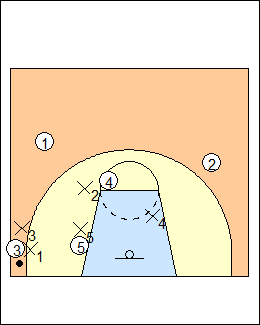 | 8 When the trap is on (e.g., 3 is a shooter), X3 traps with X1. X5 and X2 are the interceptors, X2 can look to steal a pass out to 1, but first covers the high post. X4 is the goaltender but with a trap in the corner looks for steals on the weakside. Greenberg - trap a good shooter in the corner, the other slides do not change. Bennett - trap the corner to get the ball out of the hands of a great shooter. coachesclipboard.ca - X2 takes away the sideline pass, X5 cuts off passes to the middle, wing X4 takes the long skip pass. Corno - if 3 is facing the basket, X2 guards the high post and X4 jams the middle of the lane, covering the basket and all lob passes. Scariolo - X2 does not anticipate (play) the pass back to 1 unless they want to force a pass to the high post, he covers the high post and tries to steal the ball when it comes out. Hubie Brown 2-2-1 Blue option - allow a pass out of the corner, defenders cover the block, elbow, and protect the basket. Sidelines - X5 fronts 5, X2 should be able to intercept a pass from the corner if it's a good trap, he's your best athlete. |
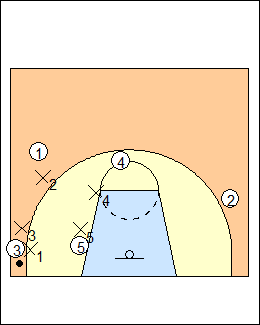 | 9 Variations a) X2 covers a pass back out to the wing, weakside wing X4 covers the high post area. DeChellis - X2 takes away a pass to 1, X4 takes away the high post. Olson - with X2 out on the wing, X4 adjusts up anticipating a skip pass to the top. Corno - if 3 has his shoulders towards the basket (i.e., his back to the baseline), X2 goes in the passing lane nearest the ball and X4 comes high to anticipate 4 at the high post. Tar Heels scramble - they like a second double-team on a short pass to the corner, it is a great time to put the offence on their heels. Since the trap is low and the low interceptor is fronting the post, they free up the goaltender to go for steals on the weakside. Syracuse 2-3 - X2 covers the passing lane back to the wing, X5 always fronts the low post, even if there is no low-post attacker, X4 is the key defender, he has to cover any high post attacker or the point guard, 2 on the far wing is left open. Hubie Brown 2-2-1 Red option - cut off the pass from the corner, cover the elbow and block. Bob Hurley - except on a direct pass to the corner, X3 goes with the pass to trap, top guy X2 goes right to the ballside elbow then shoots the gap once the ball is trapped, X4 hits the ballside elbow (Jim Boeheim). X3 can't go on a direct pass, protect, allowing X2 to drift. |
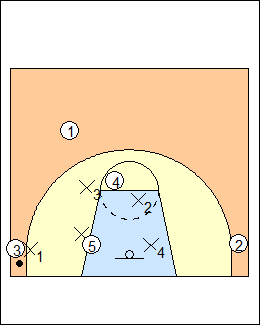 | 10 b) There is no trap when the ball is in the corner, and X3 covers the high post, e. g., if the other team has a strong low and high post. See Basketball Highway and Lute Olson 1-3-1. If the ball is skipped from 3 to 1 to 2 in the far corner, X4 must help until X1 recovers (see Jack Bennett). |
This page was made with Basketball playbook from Jes-Soft